 |
 |
|
East of Nassau, and Northeast from Great Exuma, is the long funny-shaped island of Eleuthera. It doesn’t have the same air of remoteness as the Exumas. Several settlements dot this solid land mass. Nassau is much closer, just 50 or so miles away over a shallow part of the Grand Bahama Bank. Eleuthera is near the banks’ edge. Its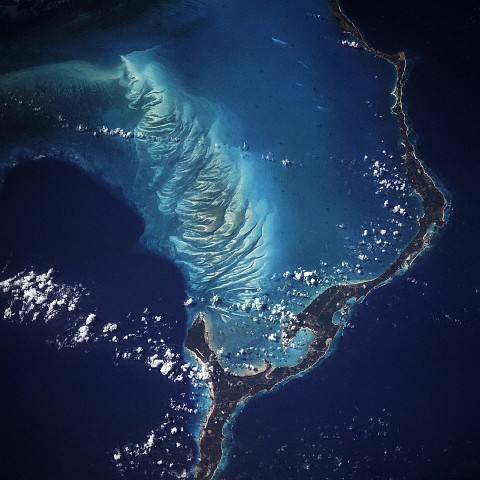 stands out like an emerald or star sapphire amidst the rich royal blue of the Atlantic. And indeed this island is a gem. Marinas cater to yachters but more so to charter fishing vessels, bound for the tropical Atlantic seas. stands out like an emerald or star sapphire amidst the rich royal blue of the Atlantic. And indeed this island is a gem. Marinas cater to yachters but more so to charter fishing vessels, bound for the tropical Atlantic seas.
|
Satellite photo of Eleuthera Island
|
Eleuthera is a common destination. Caves, shallow warm water, fishing, and rustic comfort in the island communities is something many come to enjoy on this fascinating island. This is not a tourist Mecca like Nassau or Freeport. It’s mostly pure island living, a nautical atmosphere and natural lifestyles.
This may sound like a travel brochure, but it is this 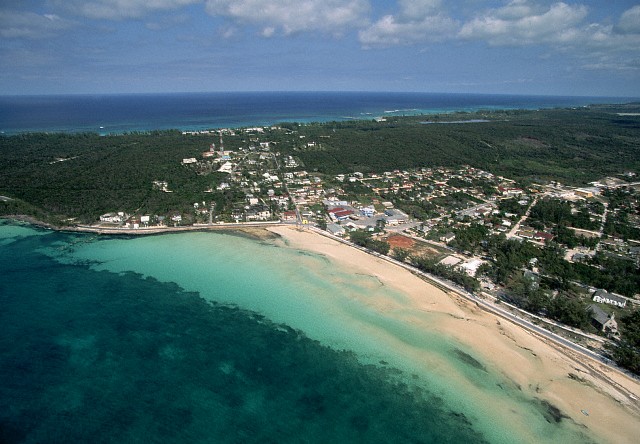 language which has attracted many to the island. Yet on occasion some have never made it to one of its airports. They’ve vanish between it and Nassau. Searches have never found a trace and wreckage has never been found . . . language which has attracted many to the island. Yet on occasion some have never made it to one of its airports. They’ve vanish between it and Nassau. Searches have never found a trace and wreckage has never been found . . .
The communities are, it seems, excellent examples of the Bermuda Triangle’s harbors. They aren’t vacation destinations, gaudy and fake. They’re colonial settlements, daily life set to the time clock of the sea and the traveler’s needs.
The deep Atlantic booms on one side. Clouds whisk by with the trade winds. Shadows scamper over the island’s tundra. But on the shallow side, the pale aqua waters are warm, indolent. Sailboats are everywhere, idle in the gentle ripples. As always their owners are friendly and eager to meet knew people.
Governor’s Harbour is a good example. Paved streets, houses, beaches and groves of trees make it look like any small town. It’s not the paradise of palm trees. These islands are little chunks of Florida, green, craggy, flat, sometimes honky-tonk mixed with the scent of tar, old schooners and hanging fish.
White Man’s diseases and ignorance wiped out the populations of these islands. These settlements are built upon rich legends few know anymore. Ancient histories played out here and yet their voice is silence. Only the Bimini Road is a testimony to some 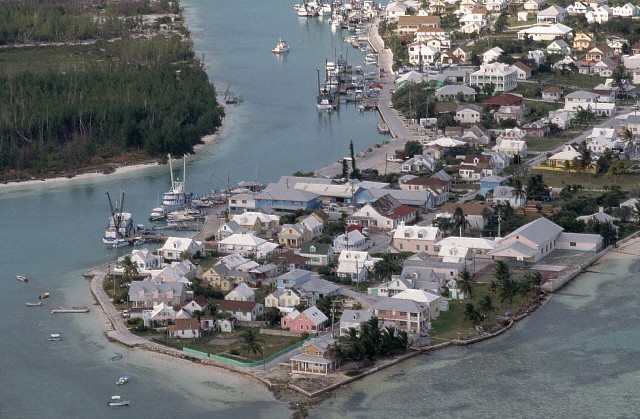 ancient and cyclopean civilization. Some ancient peoples, long displaced to Haiti, speak about this mysterious civilization, but it perished long before even their island
culture thrived centuries before Columbus. ancient and cyclopean civilization. Some ancient peoples, long displaced to Haiti, speak about this mysterious civilization, but it perished long before even their island
culture thrived centuries before Columbus.
The only other voice is deep sea sonar and sidescan. On occasion it has traced a near perfect peak reminiscent of Egyptian pyramids. Only a few ancient Amerindian civilizations built pyramids like this. The rest were step pyramids like ziggurats with a temple at the top. Are these remnants of an ancient and mysterious island civilization of the Cyclopean period? 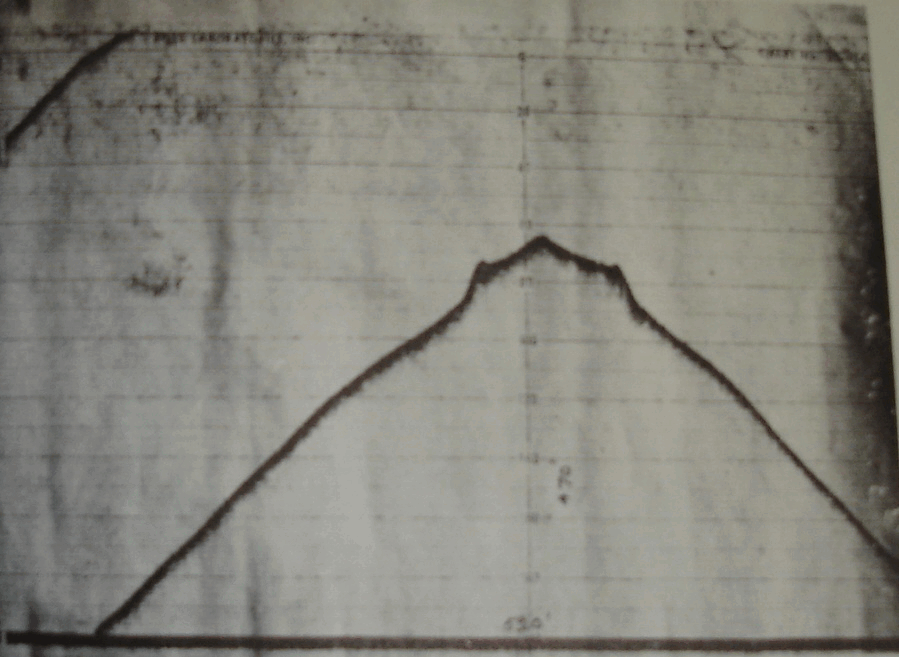 Or is it wishful interpretation? Or is it wishful interpretation?
Whichever, the allure in the Bahamas is both by land and sea and by sea bottom. The present beckons, and fleeting wisps from the past beckon us as well. Both can deceive us into many beliefs and theories, but only one thing remains sure. Many, many, have vanished here.
The mysteries and legends of the Bermuda Triangle have brought to light far more than the tragedies. The missing have brought to light an old pattern of enigmas. The first was reported by Christopher Columbus himself. Near here on the eve of discovering the New World, a strange light rose on the horizon and then hovered there. How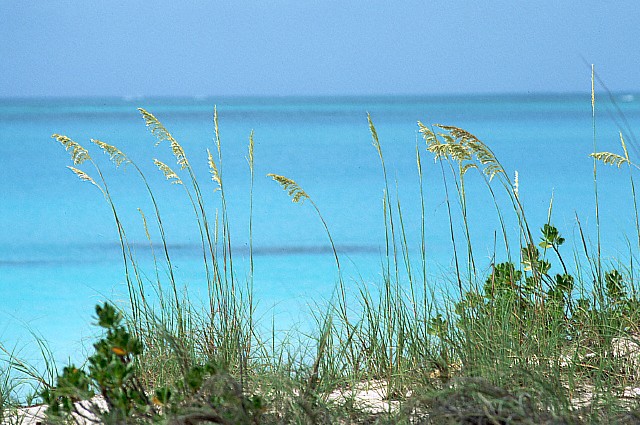 it disappeared he did not say, but they pursued after the light and on the morning discovered San Salvador or Watling Island. it disappeared he did not say, but they pursued after the light and on the morning discovered San Salvador or Watling Island.
A cross marks where it is believed Columbus must have landed in October 1492. But upon landing, found no source for the lights, not fishermen’s stale campfires nor the smoking remains of torches. Standing from a spot like in the above picture he must have absorbed the sweet taste of success. . . .But he also must have pondered mystery. The source of the light was never found. To this day, no historian is sure what he and his crew saw.
The phenomenon of unexplained lights continues around the Bahamas, and indeed the world. In 2011 one even descended and then zoomed into oblivion over the Dome of the rock in Jerusalem. If they are “ball lightning” the one that led Columbus was a fortuitous sight indeed!
There are several other lone islands breasting the strong winds of the Atlantic. Rum Cay, for instance, lies southwest of here. Adventuresome divers can still find the shaft, anchor chains and hawser holes of the H.M.S Conqueror, Britain’s first propellor driven warship. She sank in 1861 and can still be found in 30 feet of water in a staghorn gully near the breaking reef.
Close by is Long Island, once again on the Great Bahama Bank. A more rustic atmosphere again rules here in such main settlements as Deadman’s Cay and Clarence Town.
Heading southeast again, back on our main course bisecting the Bahamas, we pass over the large and squiggly Acklin’s Island, which sits on its own seamount. We have now left the Great Bahama Bank’s shallow and sometimes blinding waters behind. These islands southeast of here are in the deep blue ocean, surrounded by a halo of shallow glowing waters and shivering lines of white breakers.
|
|
|
 |
 |
|
After passing over Acklin’s we fly over Mayaguana Passage, a major sea lane for big ships coming out of the Caribbean between Cuba and Haiti’s Windward Passage. The island of Mayaguana is distant on the horizon to our left. South is the other sea lane called the Caicos Passage, another major route for freighters, leading into the heart of the Triangle. This is usually the way most ships come when sailing up through the Windwards.
Our destination will come into view soon. It is the common halfway island of Great Inagua. 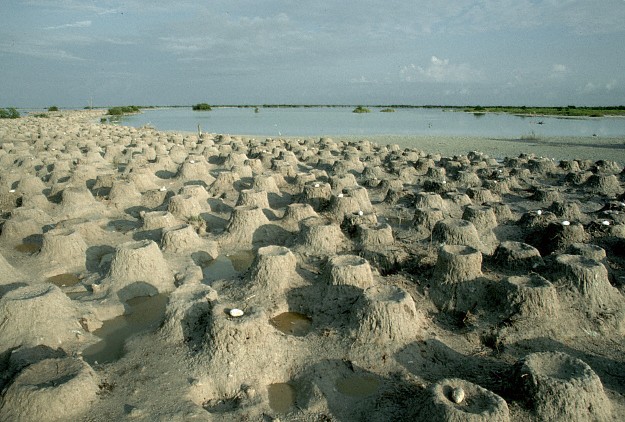 . Either coming or going to San Juan, the smaller propliners are going to stop at Great Inagua. This island, though large, is not highly populated. Its major produce is salt. Recessions have turned settlements into ghost towns. I have heard stories of the strange feeling pilots get when landing and refueling. The wind howls through a dead settlement. Shutters and screen doors squeak and slam, and since it is so near to Cuba, you never know who you’ll find! . Either coming or going to San Juan, the smaller propliners are going to stop at Great Inagua. This island, though large, is not highly populated. Its major produce is salt. Recessions have turned settlements into ghost towns. I have heard stories of the strange feeling pilots get when landing and refueling. The wind howls through a dead settlement. Shutters and screen doors squeak and slam, and since it is so near to Cuba, you never know who you’ll find!
Flamingo nesting on Great Inagua is a sight to see. Above, they build their little mounds and lay their eggs on top. Great Inagua is a very flat island and one really feels they are out in the middle of nowhere here.
En route to Great Inagua is Hogsty Reef, where one could see the silhouette of a stranded Liberty Ship, caught on its coral atoll shores while steaming towards one of the above mentioned major passages. It sits, high in the water, rusted and corroded like a guardian on the bank some 5 miles outside the entrance.
Unless one is headed toward the Turk and Caicos Islands nearby to the northeast, you’re going to head out over deep ocean and skirt the island of Hispaniola, upon which are the countries of Dominican Republic and Haiti. This can be the most boring part of the journey.
Smaller charters fly these latitudes at much lower altitudes than the big airliners and cargo jets. Britten-Norman Islanders, well named because they are perfect for ferry-flights, Aero Commanders, beefy Queen and King airs, hum along overhead and for hours the passengers gaze at a deep blue ocean.
More than one has been lost on this route. In fact, quite a few have vanished. None ever sent a Mayday. A famous case where a mayday was sent is that of Carolyn Coscio and her boyfriend in her Cessna 172 in 1969. She was trying to find Grand Turk but she either became lost, couldn’t see the island or panicked and crashed. A search found no trace and there is no explanation why the Cessna vanished. 1969. She was trying to find Grand Turk but she either became lost, couldn’t see the island or panicked and crashed. A search found no trace and there is no explanation why the Cessna vanished.
Coscio’s case is not unique for this area. On January 21, 1960, an almost similar case happened to newlyweds George and Margaret Dickson in his Cessna 180. Trying to find Caicos, he eventually sent a mayday indicating his compass wasn’t working. A nearby Air Force C-54 aircraft tried to home in on his signal, and continued to circle over the sea after it faded, all in a vain attempt to locate the missing aircraft. Over a week later the Coast Guard expanded its search, with 26 aircraft and ships searching the area. No trace was found, though the plane was well provisioned with life rafts and jackets.
The others vanished silently or their maydays were never picked up in this lonely blue desert. There’s a lot of time to think here.
One’s mind goes back to the Great Bahama Bank and all its enigmas. There is time to wistfully contemplate concepts of time and space warps or even alien interdiction. Even without such esoteric theories there’s the tempting facts of electromagnetic aberrations and the genuine possibility that the Bermuda Triangle’s famous— indeed most famous— enigma of unusual forces plays a hand.
A great scientific truth may be shouting at us for discovery, but we are not used to land and sea working so closely in tandem as in the Bahamas. We only hear our voices recite theories of accidental and mundane crashes, though we really have no clues whatsoever that suggest anything prosaic.
The idea of ancient civilizations is also alluring, especially one as famous as “Atlantis.” There is time to think of that too. Pauline Zelitisky, a scientist with National Geographic, inspired some of the most interesting and recent sensations regarding this theory. She has not minded being dogmatic about her finds off Cabo San Antonio, Cuba. Sonar and side scanning systems detected what appeared to be a vast city there. One edifice appears to be a pyramid 115 feet tall.
Despite initial skepticism, scientific interest has continued to back expeditions. Fossils creatures were found in stone samples taken from the depths of 200o feet. In each case they contained creatures that could never have lived at those depths.
Altogether the above suggests huge prehistoric city was plunged beneath the sea in some tectonic upheaval reminiscent of Atlantis.
Far from the Mediterranean though it is, there are many who see it as the super Atlantis of clairvoyant Edgar Cayce who predicted Atlantis would be found in the Bahamas and neighboring islands.
During his “readings” in the 1930s he said that Atlantis was a super-civilization of prehistory and its last remnant was the Great Bahama Bank, that huge island just beneath the sea of which the Bahamas’ touristy islands are only former hillocks. This area, according to Cayce, sank about 12,000 years ago.
In 2004 Zelitisky boldly declared “We think that this is no longer a hypothesis, it is a fact, supported by scientists who specialize in geology and archaeology. The existence of pyramidal structures deep underneath Cuban waters is verified. We only needed to gather the details.”
A couple of hours and we cross the outlet of Mona Passage. Our next sight of land is Puerto Rico. The journey is finally over when San Juan’s El Morro Castle is clearly in view. It stands proudly boastful against the pounding sea assailing its ramparts. It is daubed with foam as the sea continues to froth at its rocky cliffs. We are finally come to La Isla Bonita, the third corner of the Bermuda triangle.
|
|